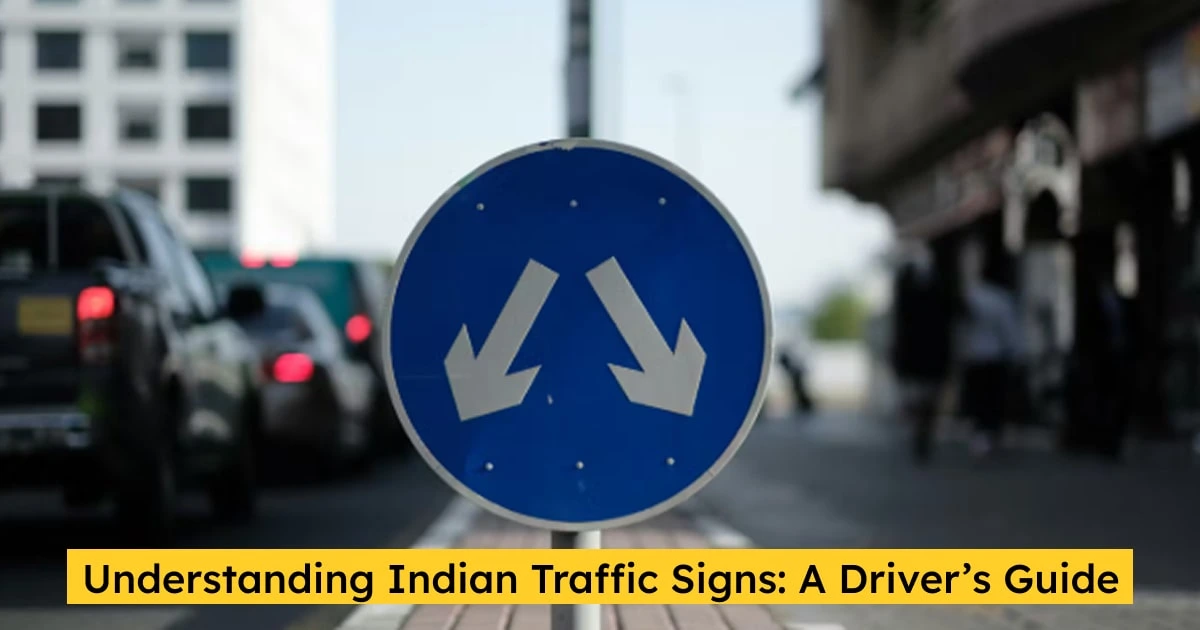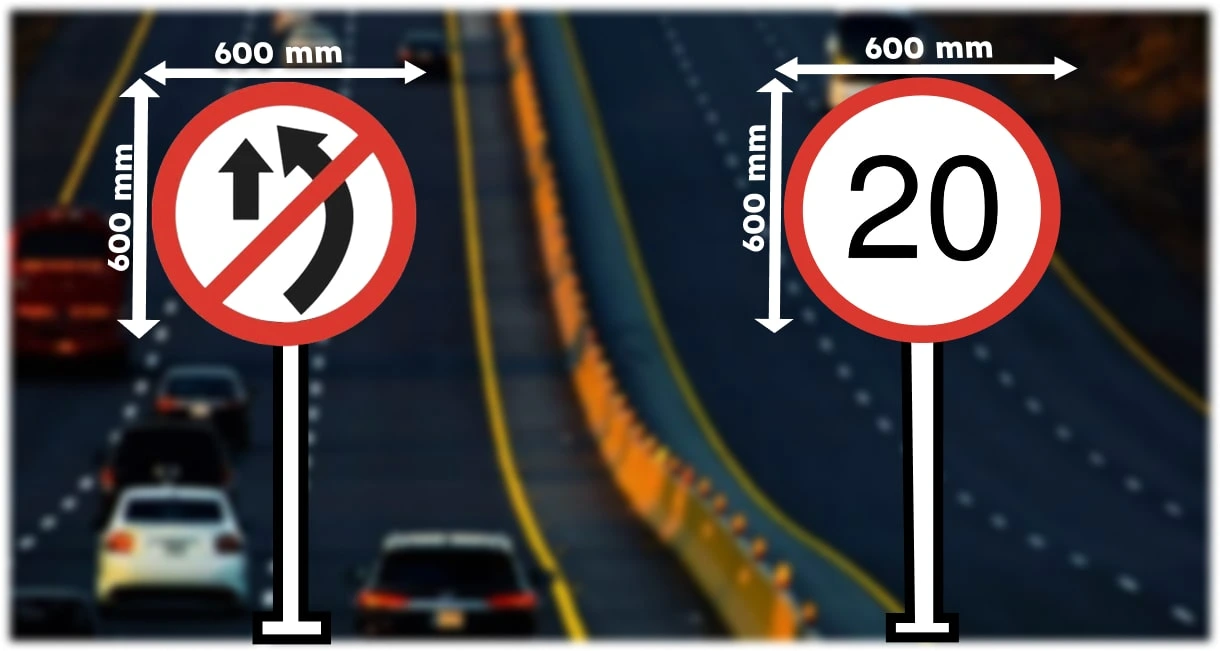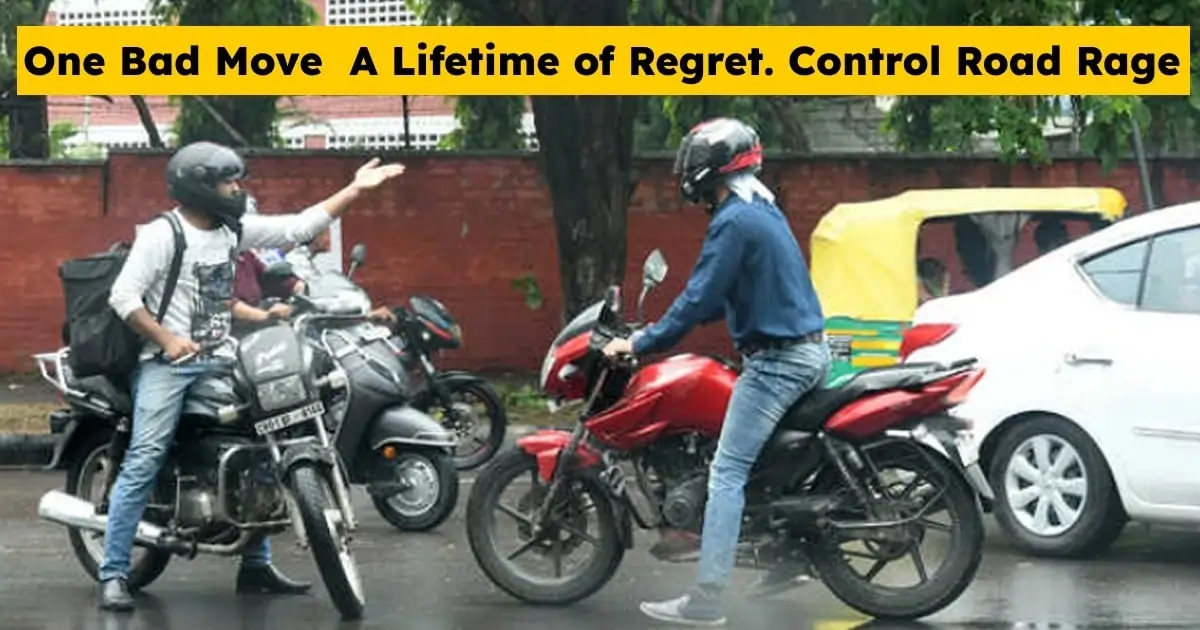Navigating the roads of India can be a thrilling experience, but it's essential to prioritize safety at all times. Whether you're a seasoned driver or a novice, understanding and adhering to road signs is crucial for safe and efficient travel. In this guide, we'll delve into the essential road signs every driver should know in India, helping you stay informed and confident behind the wheel.
What Are the Traffic Signs in India?
Traffic signs in India are official symbols and markings placed along roads to guide and regulate drivers, pedestrians, and other road users. Without lengthy explanations, they convey critical information—a speed limit, a sudden curve, or a school zone. These signs are extremely simple in design, which anyone can understand. Knowing these traffic signs is also necessary to pass the driving test.
With over 354 million registered vehicles in India (a number growing daily!), understanding these signs is no longer optional—especially in busy urban hubs like Delhi or Mumbai.
How Are the Traffic Signs in India Designed?

Indian traffic signs follow a system established by the Indian Road Congress (IRC) and the Motor Vehicles Act. They incorporate universal symbols recognized by most drivers, ensuring consistency using eye-catching bright colours that can be spotted in fog and other harsh weather conditions. Here are key factors in sign design:
- Colour Coding
- Red often represents prohibitions or mandatory actions (e.g., Stop, No Entry).
- Blue or Green can denote information or directions.
- Yellow/Amber typically signals caution or warning.
- Shape
- Circular signs often mean regulations (e.g., speed limits).
- Triangular signs generally warn of hazards (e.g., bends, crossroads).
- Rectangular signs provide information (e.g., petrol pump and hospital directions).
- Reflective Materials
- Most modern signs use retroreflective sheets to ensure visibility at night or in low-light conditions.
- High-intensity reflectors help drivers read from a distance, preventing sudden braking or confusion.
Why It Matters: A well-designed traffic sign can be identified in under two seconds—an important factor when travelling at highway speeds.
What Is the Standard Size of Traffic Sign Boards in India?

India's traffic signs vary in size based on the type of road and the intended visibility distance. General guidelines by the IRC include :
- Stop Signs: Typically 600–750 mm on lower-speed roads; can increase to 900–1200 mm on highways or expressways.
- Warning (Cautionary) Signs: Usually 600 mm for standard roads, scaling up to 900–1200 mm in high-speed areas.
- Informatory Signs: Often 600 × 450 mm or larger, especially for overhead gantry signs.
Always refer to the latest IRC/MORTH guidelines for specific requirements based on road type and speed limits.
Types of Traffic Signs or Road Safety Signs
Indian road signs typically fall into three main categories, each serving a distinct purpose:
- Mandatory Signs
- Cautionary Signs
- Informatory Signs
We'll explore each type in detail below.
1. Mandatory Traffic Signs
All road users must follow these signs. They include rules such as "Stop," "Give Way," "No Entry," and more. Violating mandatory signs often carries immediate penalties.

Examples:
- Stop Sign
- Meaning: You must come to a complete halt.
- Penalty: Fines can start from ₹1,000 if ignored.
- No Entry
- Meaning: Prohibits vehicles from entering.
- Penalty: Around ₹500 + potential license points if violated.
- No Overtaking
- Meaning: Overtaking is strictly prohibited on this stretch.
- Penalty: This may vary by state but can be ₹1,000 or more.
| Traffic Signs | Meaning |
|---|---|
| Stop | Drivers should immediately stop after seeing this. |
| Give Way | Indicates the traffic to give way to the fellow traffic on the right. |
| Straight Prohibitor No Entry | Indicates restricted area. |
| Pedestrian Prohibited | Indicates the place is restricted for walking. |
| Horn Prohibited | Honking is restricted in areas marked with this sign. |
| No Parking | Restricts parking of vehicles in areas marked with this sign. |
| No Stopping or Standing | No vehicle or person should stand or stop at the locations marked with this sign. |
| Speed Limited | Following the mentioned speed limit is mandatory in these designated areas. |
| Right Hand Curve | Cautions the driver about a right hand curve. |
| Left Hand Curve | Cautions the driver about a left hand curve. |
| Right Hair Pin Bend | Cautions about a sharp right turn. |
| Left Hair Pin Bend | Cautions about a sharp left turn. |
| Narrow Road Ahead | Cautions the driver about a narrow road. |
| Narrow Bridge | Indicates the driver about a narrow bridge on the road ahead. |
| Pedestrian Crossing | This sign indicates that pedestrians should cross the road. |
| School Ahead | Cautions the driver about a school nearby. |
| Round About | Indicates the driver about a circular intersection. |
| Dangerous Dip | Cautions the driver that there is a sharp dip nearby. |
| Hump or Rough | Cautions the driver about a hump nearby. |
| Barrier Ahead | Indicates to the driver that there is a barrier in the road ahead. e.g. Tolls |
Cautionary Traffic Signs
Cautionary (or warning) signs alert drivers to potential hazards or unusual road conditions ahead. They're typically triangular and feature a symbol indicating the specific caution.

- Right or Left Hairpin Bend
- Meaning: Warns of extremely sharp turns.
- Tip: Slow down in advance to maintain vehicle control.
- Steep Ascent / Descent
- Meaning: The road ahead inclines or declines sharply.
- Scenario: Trucks must shift gears; smaller cars should maintain speed control to avoid accidents.
- School Ahead
- Meaning: Children may be crossing.
- Consequence: Fines may start from ₹500 if you exceed the speed limit in a school zone.
Some highways in hilly regions like Himachal Pradesh are filled with cautionary signs like "Falling Rocks" to prevent disaster if you're driving too fast.
| Traffic Signs | Meaning |
|---|---|
| Right Hand Curve | Cautions the driver about a right hand curve. |
| Left Hand Curve | Cautions the driver about a left hand curve. |
| Right Hair Pin Bend | Cautions about a sharp right turn. |
| Left Hair Pin Bend | Cautions about a sharp left turn. |
| Right Reverse Bend | Caution the driver that there is a zigzag turn to the right. |
| Left Reverse Bend | Caution the driver that there is a zigzag turn to the left. |
| Steep Ascent | Indicates that there is a steep rising upwards nearby |
| Steep Descent | Indicates that there is a steep descending downwards nearby |
| Narrow Road Ahead | Indicates to the driver that the road ahead merges into a narrow road. |
| Road Wideness Ahead | Indicates to the driver that the road ahead widens. |
| Narrow Bridge | Indicates the driver about a narrow bridge on the road ahead. |
| Slippery Road | Cautions the driver that gravel or loose earth keeps falling on the road. |
| Cycle Crossing | Indicates that the road is meant for riding a bicycle. |
| Pedestrian Crossing | This sign indicates that pedestrians should cross the road. |
| School Ahead | Cautions the driver about a school nearby. |
| Men At Work | Indicates that labourers are working on the road ahead. |
| Cattle | Indicates the possibility of cattle on the road nearby. |
| Falling Rocks | Cautions the drivers that the road ahead is prone to falling rocks. |
| Ferry | Indicates the presence of ferry service. |
Informatory Traffic Signs
Informatory signs provide guidance rather than rules or warnings. They're usually rectangular and cover details like fuel stations, rest areas, hospitals, or directions to nearby cities.

- Petrol Pump
- Meaning: Indicates fuel availability.
- Benefit: Vital during long drives in remote areas.
- Hospital
- Meaning: A medical facility is nearby for emergencies.
- Parking Lot
- Meaning: Shows authorized places to park vehicles safely.
Informatory signs may not carry direct penalties, but ignoring them can lead to missed turns, time loss, or failure to find needed emergency services.
| Traffic Signs | Meaning |
|---|---|
| Public Telephone | Indicates that a telephone is present nearby. |
| Petrol Pump | Indicates that a petrol pump is present nearby. |
| Hospital | Indicates that a hospital is present nearby. |
| First Aid Post | Indicates the presence of a first aid facility nearby. |
| Eating Place | Indicates the presence of an eating place nearby like restaurants, cafes, etc. |
| Light Refreshment | Indicates the presence of a light refreshment facility nearby. |
| Resting Place | Indicates the presence of a resting place nearby. |
| No Thorough Road | Indicates the unavailability of exit on the road |
| No Thorough Side Road | Indicates the unavailability of a thorough side road on the main road. |
| Park This Side | Shows where to park the vehicle. |
| Parking Lot Scooter and Motorcycle | Indicates the parking lot for scooters and motorcycles. |
| Parking Lot Cycle | Indicates the parking lot for bicycles |
| Parking Lot Cars | Indicates the parking lot for cars. |
Importance of Traffic Signs in Daily Life
- Safety Assurance: Traffic signs act as crucial reminders of rules and regulations, ensuring the safety of all road users. Especially vital during outstation travel or extended road trips where unfamiliar routes make clear signage critical.
- Order Maintenance: They help organize flow, preventing congestion on the roads.
- Navigation Aid: Traffic signs provide directional guidance, helping drivers navigate unfamiliar routes and reach their destinations properly.
- Legal Compliance: Adhering to traffic signs is essential for safety and avoiding penalties and legal consequences.
- Communication Tool: They convey standardized messages using universally recognized symbols, facilitating communication between diverse road users.
- Awareness Promotion: Traffic signs raise awareness about hazards, speed limits, and pedestrian crossings, promoting responsible driving behaviours.
- Emergency Preparedness: Signs indicating emergency services' locations aid in quick access to assistance during accidents or emergencies.
- Environmental Consideration: They promote eco-friendly practices by indicating environmental zones or speed limits, minimizing pollution and environmental impact.
- Education Tool: Understanding traffic signs is fundamental to driver education, empowering individuals with knowledge of safe driving habits.
- Cultural Significance: Traffic signs reflect societal values and priorities, fostering a collective commitment to road safety and community well-being.
Why Is It Crucial for Kids to Know Traffic Signs?

- Building Early Awareness
- Children who grow up understanding basic traffic signs (like Stop, School Zone) are more cautious pedestrians and future drivers.
- Pedestrian Safety
- Kids walking to school should recognize "Pedestrian Crossing" or "School Ahead" signs to cross safely.
- Road Sense Development
- A child familiar with signage will respect rules early, fostering responsible road habits.
Tip for Parents: Make it a fun activity—point out signs during family drives or walks. Simple flashcards at home work wonders, too!
What Are the Functions of Traffic Signs in India?
- Regulation: Mandate speed limits, no-parking zones, or one-way streets.
- Warning: Alert drivers to hazards like sharp curves, slippery roads, or steep climbs.
- Information: Provide directions, facility locations (petrol pumps, rest areas), or route guidance.
- Enforcement: Indirectly, traffic signs help the police and RTO enforce laws—no excuse if there's a visible sign!
- Accident Prevention: A timely warning sign can prevent collisions and save lives.
Hand Signals by Traffic Police
Traffic in many busy Indian cities often relies on traffic police to coordinate movement, especially where signals malfunction or in high-traffic events (festivals, rallies, etc.). Key hand signals to watch for:
- Stop Gesture
- A raised palm facing you. It's the universal signal to halt immediately.
- Move Forward
- Traffic police might wave a hand from back to front, signalling vehicles to proceed.
- Turn or Change Lane
- A directional wave of the hand indicates a turn.
Tip:Always maintain a safe distance. Sudden stops are common if police abruptly change signals.
Hand Signals by Drivers
Drivers themselves are expected to use hand signals if vehicle indicators fail or to add clarity:
- Right Turn: Right arm straight out the window, palm facing forward.
- Left Turn: Right arm extended out and bent at the elbow, hand pointing up.
- Slowing Down/Stopping: Right arm out the window, moving up and down to indicate a decrease in speed.
Note: These come in handy when brake lights or turn signals are not working or are easily visible to others in poor weather.
Road Marking or Pavement Marking Signs in India
Beyond signboards, road markings are equally crucial. Common types include:
- Lane Markings
- You can change lanes in the broken white lines lane if it's safe.
- Stop Lines
- A thick white line before intersections or signals. You must stop before this line, not on it.
- Pedestrian Crosswalks
- Marked by white stripes (zebra crossing). Vehicles must yield to pedestrians.
Importance: Road markings often go unnoticed, yet ignoring them is illegal and dangerous. They're integral to traffic safety, especially on multi-lane roads.
Road Rage in India

Despite clear signs and markings, road rage is a rising concern:
- Common Causes
- Bumper-to-bumper conditions test everyone's patience while creating traffic congestion.
- Many get irritated when drivers ignore the "No Overtaking" or "No Horn" sign.
- Cutting lanes without signals, tailgating, or honking excessively.
- Effects
- Escalation into verbal or physical altercations.
- Heightened accident risks and injuries.
- Prevention
- Adhere to traffic signs and signals meticulously.
- Stay calm; no sign is worth losing your temper or causing an accident.
- If you find road rage challenging, hire a professional driver—let them deal with stress on the road while you sit back and relax.
Conclusion
Understanding traffic signs in India isn't just about ticking a box for a driving test. It's about safeguarding lives, avoiding steep fines, and ensuring smooth journeys. From mandatory red circles to cautionary triangles and informatory rectangles, every sign on the road has a crucial role in maintaining order.
- Kids benefit from learning signs early, growing up as conscious road users.
- Adults can avoid hefty fines and accidents by heeding the rules.
- Employers hiring professional drivers should verify that these drivers know their signs inside out.
If you'd rather not worry about sign violations, book a driver with Driveronhire.com. We rigorously test each chauffeur's knowledge so you can travel with peace of mind—no more worrying about sudden fines or last-second swerves. Stay informed, drive safe, and remember: The best road journeys are those where everyone respects the signs—and each other.
